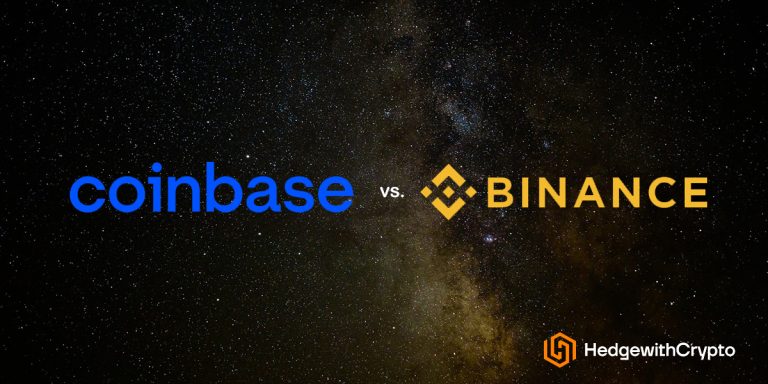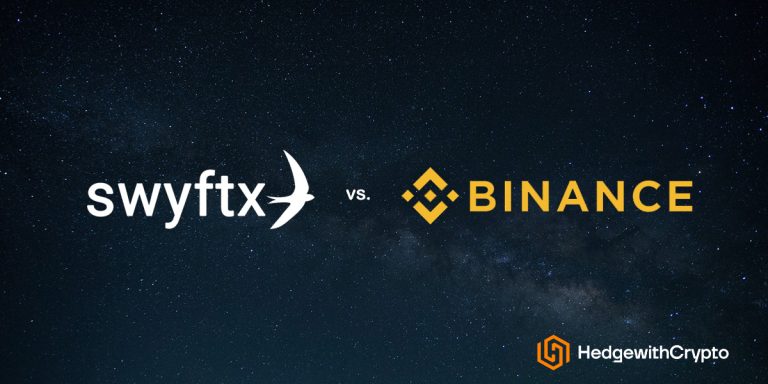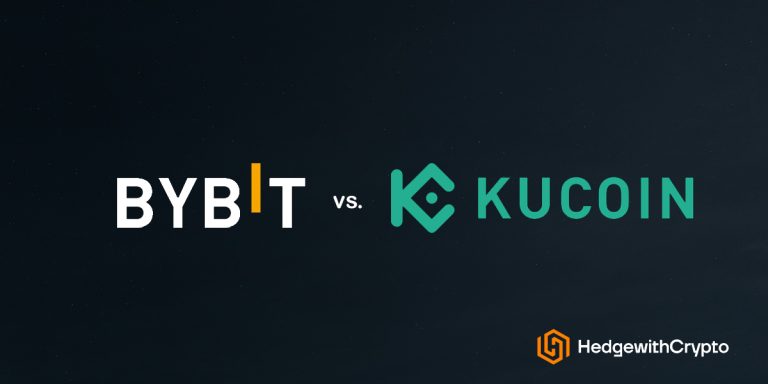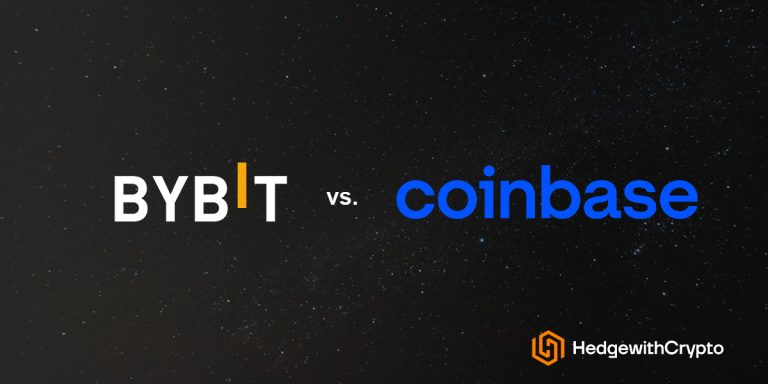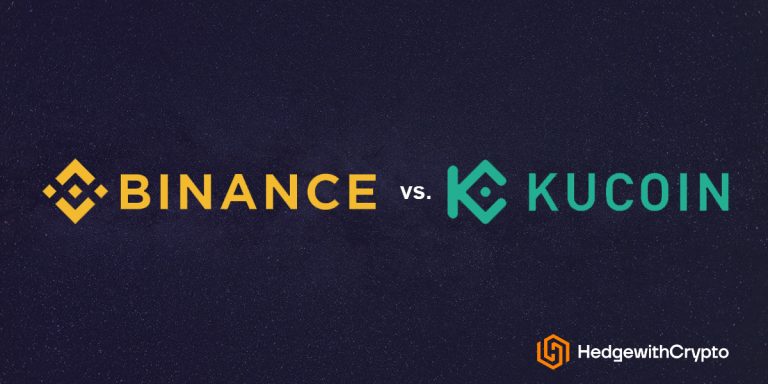We may earn a commission from links on our site, but this doesn’t affect our reviews. Learn more.
Hedge With Crypto is an independent publisher that provides objective and free content. Articles on our site may include links to our partners. If you click on these links, we may earn a commission. However, our editorial content remains unbiased, reflecting our own opinions or the general information available. For more information on our company policies, read the Affiliate Disclosure, Privacy Policy, and Terms & Conditions.
Bybit vs. Binance
Hedge with Crypto aims to publish information that is factual and accurate as of the date of publication. For specific information about a cryptocurrency exchange or trading platform please visit that provider’s website. This information is general in nature and is for educational purposes only. Hedge with Crypto does not provide financial advice nor does it take into account your personal financial situation. We encourage you to seek financial advice from an independent financial advisor where appropriate and make your own enquiries.
TABLE OF CONTENTS
Bybit vs Binance – Quick Verdict
Both Binance and ByBit are high-volume exchanges that focus on providing an array of features for more experienced investors. Binance has a huge audience and can be useful for both beginners and the crypto-savvy. In comparison, ByBit is lacking in features and less friendly to those without much trading skill. However, those seeking a way to trade derivatives with margins up to 100x will find ByBit the superior option.
While Binance is our number one pick for the best alternative to Bybit as it offers slightly more features and trading liquidity, ultimately, which exchange is “better” will depend on whether investors wish to actively trade with leverage (ByBit wins). Or if they want to participate in the blockchain ecosystem (Binance wins).
Start trading on Binance and ByBit.
| Binance | ByBit | |
|---|---|---|
| Website |
|

|
| Promotion | Up to $100 welcome bonus | 0% trading fees for 30 days (spot only) |
| Fiat Currency | USD, EUR, GBP, AUD, CAD, +22 Others | USD, EUR, GBP, AUD, CAD, +125 Others |
| Supported Cryptocurrency | 385 | 331 (608 trading pairs) |
| Max. Trading Fee | 0.1% (spot) and 0.02% / 0.04% (Futures) | 0% (spot), 0.06% / 0.01% (futures) |
| Overall Rating | HedgewithCrypto Score 4.8 / 5 We provide an overall weighted average rating out of 5 stars. Our ratings are based on objective criteria like the ease of use, fees, deposit methods, customer support and availability. Our reviews are not influenced by 3rd parties. Click here for further information about our rating methodology and a full list of categories we review against. Visit Binance |
HedgewithCrypto Score 4.8 / 5 We provide an overall weighted average rating out of 5 stars. Our ratings are based on objective criteria like the ease of use, fees, deposit methods, customer support and availability. Our reviews are not influenced by 3rd parties. Click here for further information about our rating methodology and a full list of categories we review against. Visit ByBit |
| Review | Read our full Binance Review | Read our full ByBit Review |
Binance Overview
Binance is the world’s largest cryptocurrency exchange based on multiple metrics — trading volume, weekly visits, and liquidity. The platform is renowned for being a reliable and fast way for intermediate-advanced investors to build their digital currency portfolios. Binance has many useful features, including a comprehensive earning program, an NFT marketplace, and an OTC service. Undoubtedly, Binance is one of the most popular platforms in the world for both retail and institutional investors.
Binance has occasionally come under fire due to lack of regulation and has therefore been banned (or can only provide limited use) in certain nations. Given its huge customer base and revenue, Binance is a prominent target for malicious actors looking to hack or exploit the platform. Despite these issues, the exchange is still generally considered trustworthy and reputable.
Although Binance is focused more on blockchain-based features, the platform still provides comprehensive services for advanced day and swing traders. Binance’s deep liquidity and a huge range of altcoins give it greater money-making potential than some other platforms. Traders can place leveraged orders, borrow and lend assets, and trade derivatives on the Binance platform. Additionally, new users to Binance can claim up to $300 in bonuses with a Binance referral code and using our link.
Binance Pros:
- #1 ranked exchange globally for liquidity, trading volume and average weekly visits
- Boasts one of the largest lists of altcoins of any crypto investment platform
- Competitive fees and passive earning opportunities
- Brimming with useful features like charting, lending and an NFT marketplace
- Great range of deposit methods for multiple fiat/cryptocurrencies
Binance Cons:
- The massive list of features and coins can overwhelm beginners
- Fiat withdrawal fees can be high (depends on currency)
- Limited services for multiple nations — US residents can’t use the main exchange
- Poor customer service and response times
- Has been targeted by hackers
ByBit Overview
ByBit was founded in 2018, around the same time other derivatives-based crypto exchanges started to crop up. In only a few years of operating, ByBit amassed four million+ registered accounts trading on the platform. The ByBit philosophy is simple — provide the best crypto margin exchange for experienced traders with everything they need. This includes the ability to speculate on hundreds of derivative pairs and even trade crypto options to amplify potential profits (and losses) with leverage of up to 100x. The trading hub comes with all the bells and whistles one would expect from a modern exchange, including a fully customizable chart, access to an order book, and basic asset information such as 24-hour trading volume.
Beyond its trading features, ByBit stacks up well in other areas too. The platform has a solid earning program that frequently offers promotions and competitions that can boost money-making opportunities. ByBit has a P2P platform to trade four cryptocurrencies easily and even hosts a decent NFT marketplace. Similarly, there is a ByBit referral code for new traders to earn a deposit bonus.
A major downside of ByBit is that it can be harsh for beginners. The user interface is very similar to Binance’s. However, the platform’s trading-centric philosophy may be off-putting to the inexperienced. Derivatives and futures contracts are best avoided by newcomers to trading, as they require a certain level of skill and knowledge to prevent quickly accumulating losses.
ByBit Pros:
- An excellent trading platform with everything an advanced trader would need
- Solid range of features, including earning hub and NFT marketplace
- Extremely deep liquidity, perfect for high-volume traders
- Efficient platform with low fees and frequent competitions/promotions
- Modern and sleek companion mobile app
- Trade with up to 100x leverage — higher than several competitors
ByBit Cons:
- Unregulated in most countries
- Doesn’t support fiat currency deposits or trades — customers must use an expensive third-party gateway
- Beginners should steer clear of derivatives
Bybit vs Binance – Features, Products & Services Compared
ByBit and Binance are two of the most feature-laden exchanges on the crypto market. Intended for intermediate to advanced users, these platforms provide all sorts of blockchain services, including an earning program, derivatives trading, and an NFT marketplace. This guide will compare each exchange’s features, products, and services to see which comes out on top.
Supported Countries
Binance and ByBit have a massive global audience, each servicing millions of residents from 100+ countries. It is much easier to look at the nations these platforms don’t support than the ones they do. Binance is restricted from use in the United States (although residents from here can use the Binance.US platform), United Kingdom, China, Malaysia, Japan, Thailand, and Iran.
Although Binance has run into regulatory issues, the company is generally licensed by financial bodies in most countries. The same cannot be said of ByBit, which reportedly lacks regulation worldwide. Because of this, ByBit is one of the more popular no KYC crypto exchanges. However, some governments have restricted the platform such as the United States, China, Singapore, parts of Canada, Cuba, and North Korea.
Winner: Draw.
It is difficult to separate Binance and ByBit here, as both exchanges boast an impressive list of supported countries. Binance does fall a little behind for some due to not servicing customers from the UK and Japan. However, ByBit is not legal to operate in the US which is one of the biggest markets. Binance.US users may not have access to certain things from the main exchange, but it is still a feature-rich platform perfect for all types of investors.
Supported Deposit & Withdrawal Methods
Binance is one of the most comprehensive platforms with a wide range of supported deposit and withdrawal methods. The specific methods available will vary depending on the asset being transferred. Fiat currencies such as AUD, EUR, and USD can all be deposited for free via bank transfer. Certain fiat currencies can even be deposited with a credit/debit card to buy crypto, although this can incur a hefty fee (1.8%+). Users can make free fiat withdrawals via bank transfer and occasionally through direct sales to a bank card. Crypto deposits are free, but withdrawals will incur a variable fee.
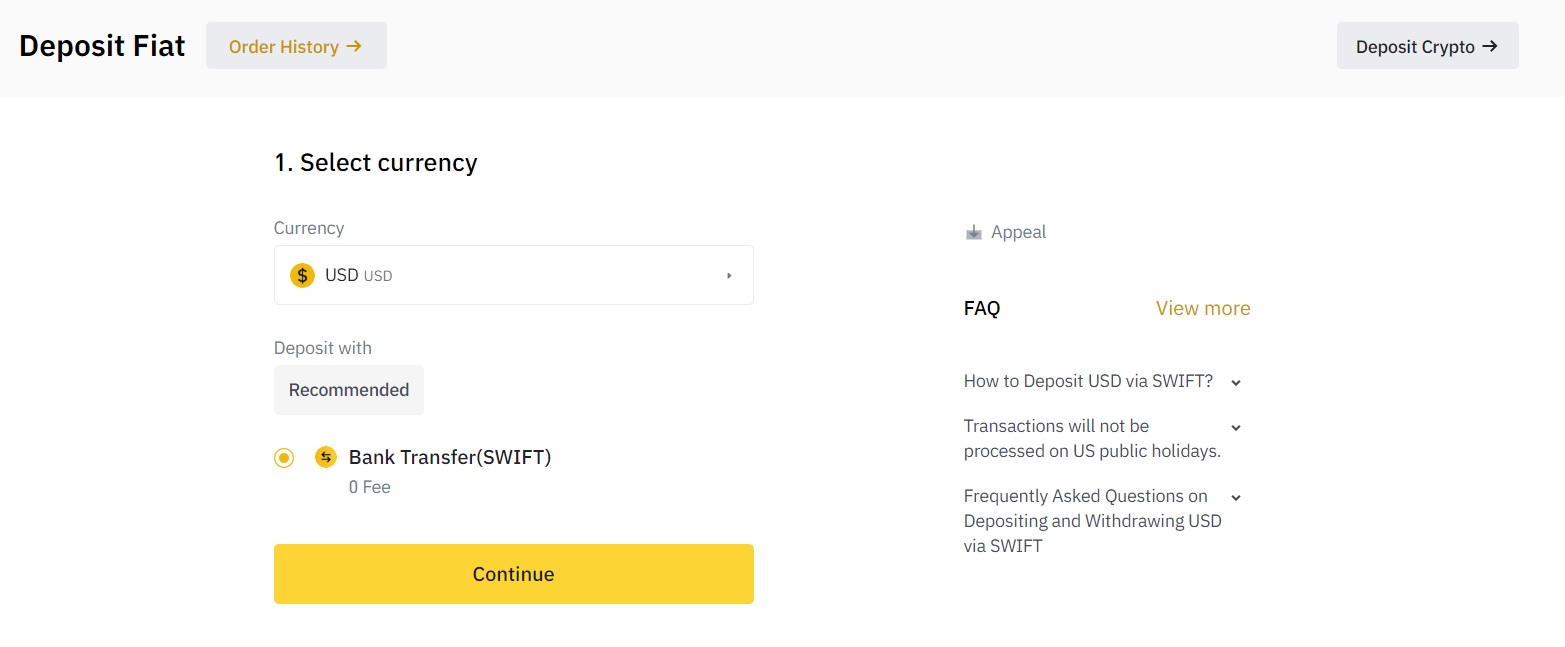
In contrast, ByBit does not accept fiat deposits and withdrawals. Instead, customers wishing to use their native currencies will need to use a third-party payment provider such as Banxa or MoonPay, which can incur unfavorable fee rates. ByBit does, however, support the deposit and withdrawal of crypto. The platform only charges standard network fees for these transactions.
Winner: Binance.
Binance is the big winner here, as they offer an impressive list of supported deposit and withdrawal methods for fiat currencies — in particular, AUD and EUR. ByBit is limited in using fiat currency on its platform, largely due to its unregulated status. Some inconvenient workarounds (third-party gateways and P2P trading) allow users to deposit fiat onto ByBit.
Supported Cryptocurrencies
Binance is renowned for its list of altcoins, which stretches beyond 600 coins at the time of writing. Binance customers have access to buying, selling, and trading all of these cryptocurrencies with deep liquidity. There are very few major assets missing from Binance’s supported digital currencies. Even the most experienced crypto investors can likely find what they need on the Binance platform.
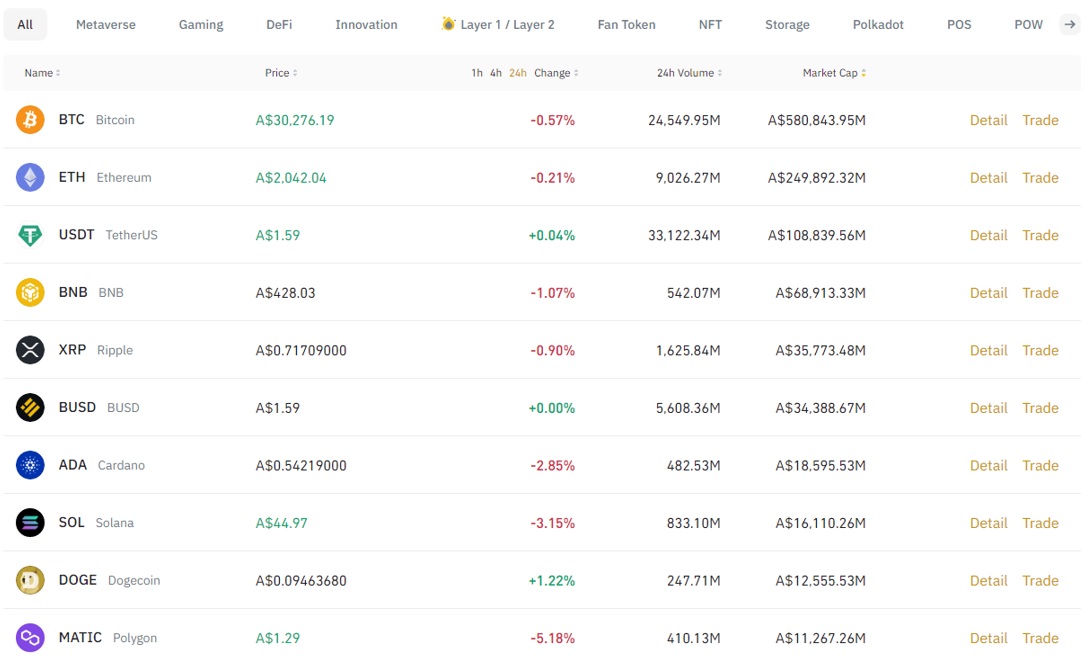
ByBit has a solid range of cryptocurrencies on offer. They allow “express” trading on 17 digital assets, including USDT, BTC, ETH, XRP, and DOGE — the simplest way to use the platform. More advanced users will find over 75 cryptocurrencies in 100+ trading pairs via the trading hub. A noteworthy negative of ByBit is that users cannot deposit Binance Smart Chain (BSC) tokens onto the platform.
Winner: Binance.
Binance has five times more cryptocurrencies available for purchase, sale, and swapping than ByBit, giving it a clear advantage. The bigger selection of cryptos to trade across all of its markets makes it a clear winner and one of the best altcoin trading platforms.
Trading Volume & Liquidity
According to Coinmarketcap, Binance is the number one ranked cryptocurrency exchange in terms of average liquidity and 24-hour trading volume. At the time of writing this article, Binance had accumulated US $11 billion in the past day of activity. To provide some perspective, the next highest-volume exchange, Hotcoin, saw $3.3 billion.

By contrast, when researching this article, ByBit didn’t sit in the top ten for volume or liquidity. The platform typically sees $1 billion+ trading volume daily and provides deep enough liquidity for institutional and retail investors.
Winner: Binance.
ByBit’s liquidity and trading volume are more than enough for most crypto traders. The platform has pretty stiff competition in Binance — the world’s most popular exchange. When it comes to liquidity and trading volume, Binance is close to unbeatable and the winner when it comes to crypto day trading platforms.
Earning Interest On Crypto
Binance and ByBit both support earning hubs with an array of opportunities for investors looking to earn passive interest on their crypto portfolios. They also both frequently run promotions of short-term interest rate boosts. Binance hosts one of the most comprehensive earning programs out of any centralized exchange. Beginners can use the “Simple Earn” hub, which operates like a high-interest savings account. Binance supports simple earning for 302 different cryptocurrencies, which is an extremely impressive figure. Binance customers with a little more experience may want to try their hand at ETH 2.0 staking or joining a mining pool.

ByBit’s Earn products have been around for a few years and returned over $6 million in passive income. Five different programs are on offer, the most used being the ByBit savings account. This hub supports 21 cryptocurrencies with very competitive APY rates. There are also ample opportunities via liquidity mining, dual asset, and LaunchPool earning programs, but they are much riskier.
Winner: Binance.
We found the ByBit earning program a bit easier to navigate and that it provided slightly greater yields on prominent tokens. However, the sheer weight of coins available for earning on Binance is extremely advantageous to investors of all skill levels that want to earn yield on their deposits.
Buying & Selling NFTs
Generally, the best platform for purchasing NFTs will be a dedicated marketplace such as OpenSea. However, the convenience of buying digital collectibles on an exchange is noteworthy, and demand for such a service has increased in the past few years. Binance and ByBit each offer NFT marketplaces of varying depths.
Neither platform is brimming with high-value, well-known NFT collections like Bored Ape or Meebits. Instead, the marketplaces are ideal for smaller, niche NFTs that work within blockchain-based games or as standalone art pieces. Binance users can mint and sell their NFTs on the market. In contrast, ByBit users can only access live drops unless they’ve contacted the support team.
Winner: Draw.
Binance and ByBit’s NFT platforms are relatively new, so they are lacking compared to more-established marketplaces. That said, they are still a respectable way for newcomers to build their NFT collections. More experience NFT collectors will likely look elsewhere.
Binance vs. ByBit: Ease Of Use
Binance and ByBit are notorious for not being the most user-friendly exchanges around. In our research, we found this reputation to be a little overstated, although still relatively true. Both platforms can be navigated rather easily, with each significant feature simple enough to find. The exchanges each have dropdown menus for major site sections, such as Trade, Buy Crypto, Derivatives, Earn, and NFTs.
The biggest issue when navigating each platform isn’t really the user design, but rather, the overwhelming number of features available. Beginners can quickly become disoriented by the weight of options, especially if they are just trying to buy a small amount of Bitcoin.
Winner: Draw.
Binance and ByBit have almost identical designs and user interfaces, making them very difficult to separate. Although some other beginner-friendly exchanges (such as Coinbase) are far easier to use, most investors should eventually become comfortable with either platform.
Binance vs. ByBit: Trading Experience
ByBit and Binance are both renowned for their professional trading interface, filled with features that should satisfy the most experienced crypto investors. The Binance trading hub includes a customizable chart, order book access, and pertinent information about the asset being traded.
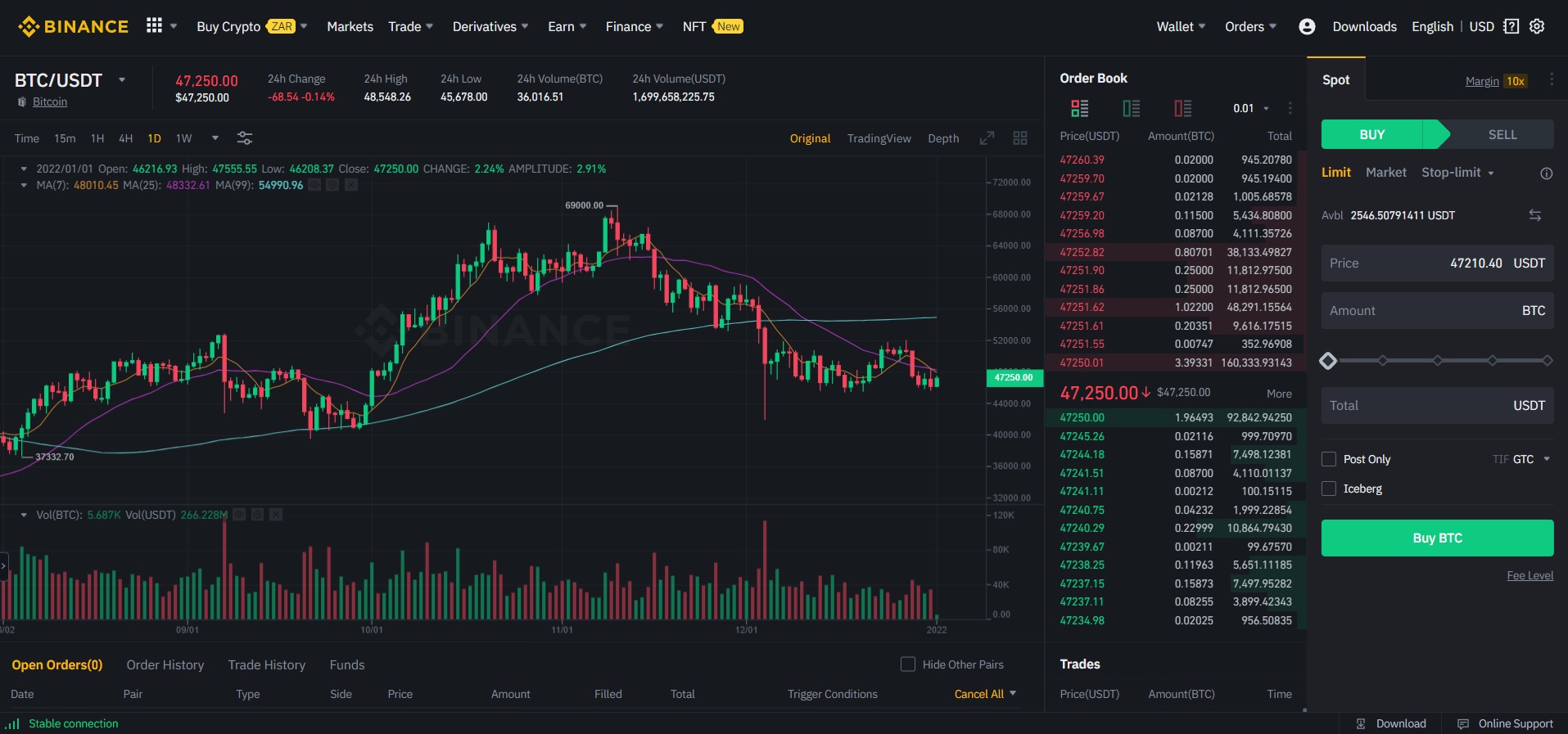
In fact, ByBit’s trading interface is almost identical to Binance’s and comes with all the same functions traders would desire. There are very few differences between the two regarding trading experience. It’s worth noting that Binance only offers leverage of up to 20x due to regulatory concerns. The platform has also removed derivatives and margin trading for pairs, including AUD, GBP, and EUR.
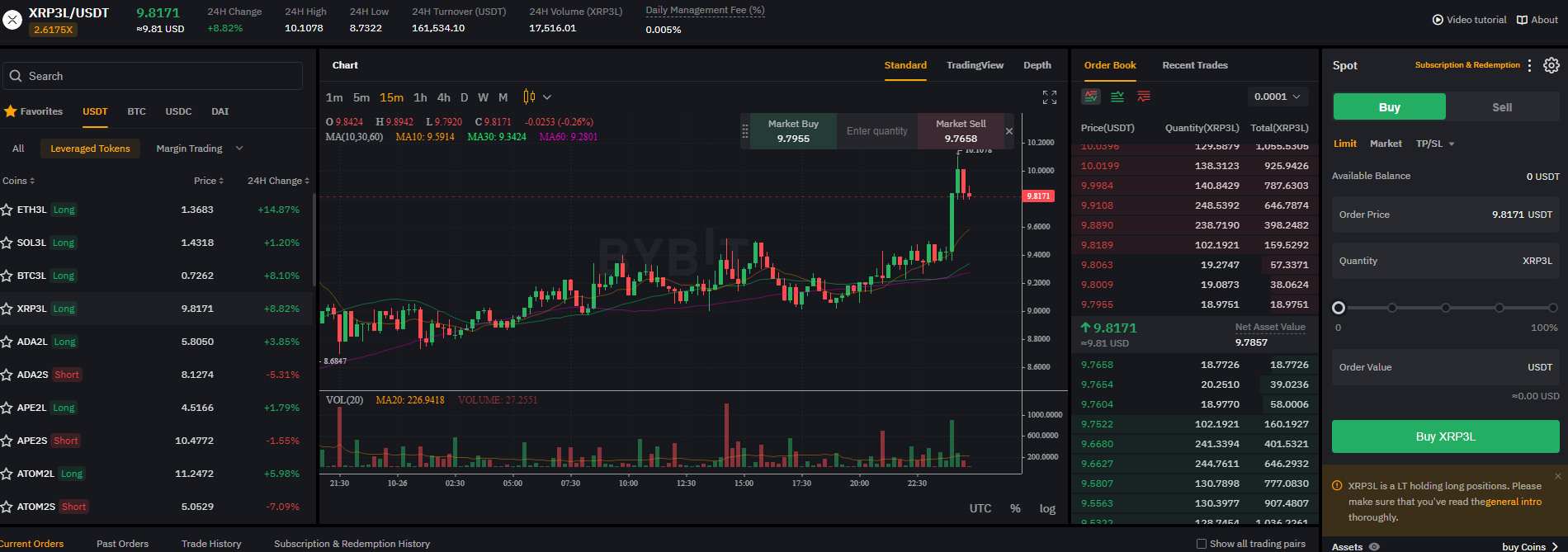
On the other hand, ByBit supports margin trading of 100x and almost no trading pairs that include fiat currency. Most ByBit derivatives are paired with USD-pegged stablecoins like Tether or USD Coin.
Winner: ByBit.
Each exchange boasts a powerful trading interface with a robust set of features. ByBit is a little more focussed on trading — particularly derivatives — than Binance, offering marginally greater trading opportunities. In addition, customers report that ByBit’s API integration with market feeds is faster than Binance’s, meaning asset prices refresh and update at world-class speeds.
ByBit vs Binance: Trading Fees
The Binance fee structure is relatively straightforward, although it does vary depending on monthly trading volume and the amount of BNB being staked. In general, Binance is one of the most cost-effective exchanges out there for beginners to use when building a cryptocurrency portfolio. Compared to other advanced, trading-centric platforms, Binance isn’t quite as cheap.
Most trades on Binance will incur a flat 0.1% fee for both makers and takers. Those with hefty trading volume – over US $1 million per month – will see their fees discounted to 0.08%. Customers using Binance Coin (BNB) to pay their trading fees will receive a 25% discount. However, Binance has recently introduced zero-fee trading on 13 Bitcoin trading pairs.
| Deposit fees | Withdrawal fees | Trading fees (no discounts) | Trading fees (max discounts) | |
|---|---|---|---|---|
| Binance | Varies, but usually none | USD $25 for wire transfers, mostly none. Standard network fees for crypto withdrawals | 0.1% | 0.06% |
| Bybit | Not applicable | Standard network fees for crypto withdrawals | 0.1% for instant buys. 0.06% for derivatives | 0% |
In comparison, ByBit has some of the lowest trading fees available on any exchange. The base fee for spot trading is 0.1%, which is exactly the same as Binance's. However, trading derivatives — the platform's primary function — sees that fee rate drop dramatically. Market makers are charged 0.01%, while takers are charged 0.06% for trading derivatives. Those with high-volume, Pro 3 accounts can enjoy zero spot and futures trading fees.
Winner: ByBit.
ByBit is one of the cheapest cryptocurrency exchanges to use in the world. Its low fee rate for derivatives (down to 0%) makes it an excellent choice for active day traders using leverage. Binance is equally competitive in fees and is the winner in this category due to the 0% trading fees on Bitcoin spot trading pairs.
Binance vs ByBit: Mobile App
Binance has developed and released a state-of-the-art mobile application that allows customers to access all things Binance on the go. The app has all the main features of the web exchange, including trading cryptocurrencies, earning passive income, and buying NFTs. The app is available via the Google Play Store (4.4/5-star rating) and Apple App Store (4.7/5-star rating). When it comes to finding a crypto app, Binance is a strong choice with over fifty million downloads to date.
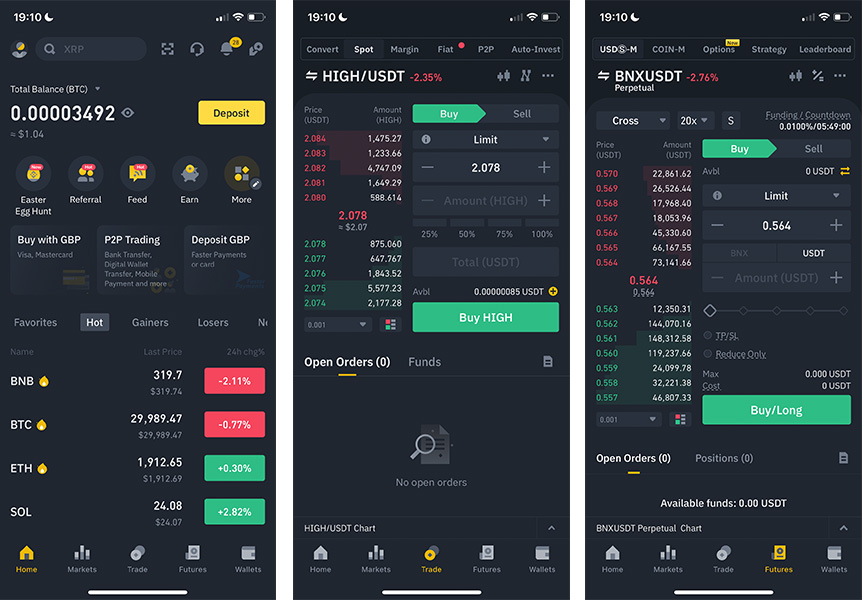
ByBit also supports an excellent, user-friendly mobile app. The smartphone application is well-designed and provides all the basic functions a ByBit customer would desire. Being able to trade ByBit’s huge range of derivatives while in transit is an excellent benefit of the platform. However, reviews on the Google Play (3.8/5-star rating) and Apple App (3.9/5-star rating) Stores suggest that application updates can have intermittent bugs.
Winner: Binance.
Binance and ByBit have clearly put time and effort into developing modern and intuitive mobile applications to support their desktop platforms. However, the larger Binance development team can pour slightly more resources into maintaining the application. This has resulted in customers responding a little better to Binance’s app than ByBit’s, reflected in their respective star ratings.
Binance vs. ByBit: Security
Each platform turns over billions of dollars worth of cryptocurrency and other assets every single day, meaning it must employ state-of-the-art security tech to ensure its safety. In general, both Binance and ByBit have bank-like security measures in place.
First, Binance uses cold storage for the majority of its digital currencies, alongside wallet and IP address whitelisting, Two-Factor Authentication (2FA), and data encryption. In 2018, Binance started its Secure Asset Fund for Users (SAFU) as an insurance protocol. The team dedicated 10% of all trading fees to the fund, which has now reached over $1 billion. The Binance exchange was hacked in 2019 to the tune of US $40 million, but since then, it has been relatively controversy-free. However, the related Binance Smart Chain has encountered hacks in more recent times, losing approximately $570 million worth of assets in October 2022.
Like Binance, ByBit holds its digital assets in a combination of hot/cold wallets to ensure a mix of safety and convenience. The team also diverts 20% of its annual budget to developing security measures and supporting an insurance fund. In its multiple years of operating, ByBit has never experienced a public hack or compromise.
Winner: ByBit.
ByBit’s lack of regulation may make it inherently seem a slightly less trustworthy option than Binance. However, ByBit is a world-class exchange that takes security very seriously — in general, it is a safe platform to use. The same can be said of Binance, however, its history of hacks (attempted or successful) does give ByBit a slight edge. Regardless, customers will likely feel comfortable depositing funds onto either exchange.
Binance vs. ByBit: Customer Support
Binance has a reasonable customer support service. The Help Centre comprises 100+ helpful articles, including answers to FAQs, walkthroughs, and guides. However, if users cannot find the help they require from these articles, Binance’s customer support can feel a little lacking. It can be difficult to get in quick contact with a support representative via live chat or email form submission.
The customer support team can provide helpful responses, but the long wait times make getting in contact with them in the first place a struggle. This lack of faith in Binance’s customer support is reflected by its ProductReview (1.9/5) and Trustpilot (2/5) scores.
ByBit has a solid reputation for customer service. The platform has a comprehensive Help Centre, like Binance, filled with useful walkthroughs on most basic functions (such as depositing cryptocurrency). ByBit also has a “learn” section, which can help beginners understand the fundamentals of derivatives trading.
Moreover, there is a live chatbot that supports multi-lingual responses. Users can request help through form submission or even by messaging ByBit on social media to get in contact with an actual customer service representative. The response times aren’t known for being lightning-fast; because of this, ByBit only has a 2.5/5 rating on TrustPilot.
Winner: ByBit
Neither Binance nor ByBit is exactly heralded for their cutting-edge customer support. At the end of the day, ByBit is the superior option due to faster turnaround times and more ways of getting in contact. Despite this, each platform’s swathe of articles should be more than enough for most basic questions.
Final Comparison Scores
To conclude this comparison of which exchange is better between Binance and ByBit, each crypto exchange has been scored using simple evaluation criteria as shown below.
| Comparison Criteria | Winner |
|---|---|
| Features, Products and Services | Binance |
| Ease of Use | Draw |
| Trading Experience | ByBit |
| Trading Fees | Binance |
| Mobile App | Binance |
| Security | ByBit |
| Customer Support | ByBit |
